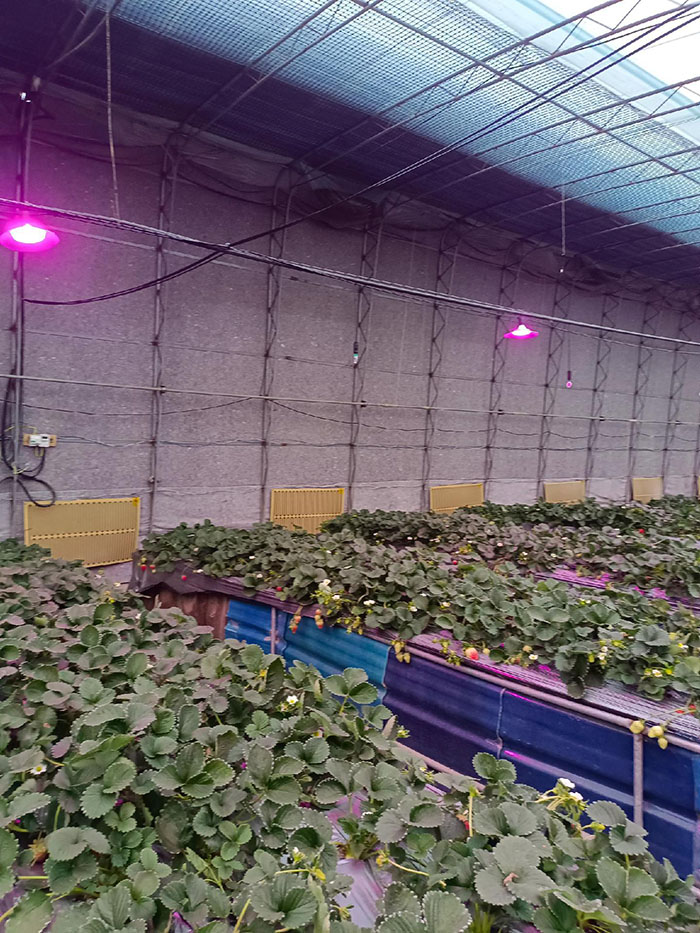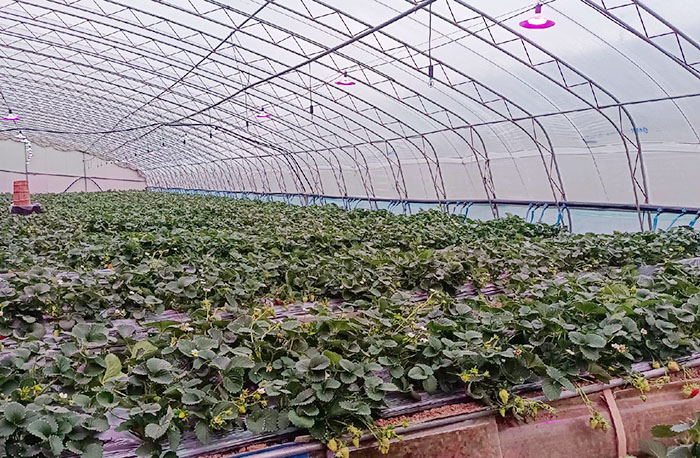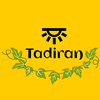Key Lighting Points
Critical Timing for Lighting (Most Important):
Flower Bud Differentiation Stage: One of the most crucial periods for lighting. Typically occurs in autumn (late September to November, depending on variety and region). Sufficient light (especially long days or appropriate Growlights) significantly increases the number and quality of flower buds formed, laying the foundation for later high yields. Focus here is on photoperiod regulation (day length control).
Flowering, Fruit Set to Fruit Expansion & Ripening Stage: The entire winter (December to March) has the weakest natural light but is when strawberries flower and fruit heavily. Lighting in this period primarily addresses insufficient light intensity, ensuring normal photosynthesis, improving fruit set rate, promoting fruit expansion, coloration, and sugar accumulation. Lighting is especially vital during prolonged cloudy, rainy, snowy, or foggy days.
Lighting Schedule:
Primary Periods: Implement lighting during early morning (before sunrise) and evening (after sunset) to extend effective daylight hours. This is the most cost-effective way to simulate long-day conditions or compensate for short days.
Early Morning Lighting: Typically 5:00 AM – 8:00 AM (adjust based on local sunrise time, starting 2-3 hours before sunrise).
Evening Lighting: Typically 4:00 PM – 8:00 PM (adjust based on local sunset time, starting after sunset and continuing to achieve the target duration).
All-Day Lighting: During prolonged cloudy/rainy/snowy/foggy weather when daytime light intensity is also severely insufficient (e.g., below the strawberry light compensation point), lighting is needed during the daytime to provide sufficient Photosynthetically Active Radiation (PAR).
Avoid Lighting: Generally not needed around midday when natural light is strongest (except during extreme overcast conditions) to save energy.
Light Source Selection:
LED Grow Lights: The preferred choice. Key advantages:
Tunable Spectrum: Can be precisely configured for strawberry needs (Red light promotes flowering/fruiting and stem elongation; Blue light promotes leaf growth and plant vigor; Far-Red light influences photomorphogenesis). Common Red:Blue ratio around 5:1 to 7:1. Full-spectrum LEDs are also a good option.
High Photoelectric Conversion Efficiency: Energy-saving, low operating cost.
Low Heat Output: Won’t scorch plants, allows closer placement.
Long Lifespan: Low maintenance cost.
High-Pressure Sodium (HPS) Lamps: Traditional supplemental lighting source.
Pros: Relatively high luminous efficacy, lower initial cost, provides some beneficial heat in winter (can be pro/con).
Cons: Narrow spectrum (dominant yellow-orange, lacks blue/violet), high heat output (risk of plant/scorching, requires higher mounting), higher energy consumption than LEDs.
Fluorescent Lights (T5/T8 Plant Tubes): Lower efficiency, relatively broad but weak spectrum. Suitable for propagation or low crops; less common in commercial strawberry production greenhouses.
Light Intensity Requirements:
Strawberry light compensation point is approx. 30-50 μmol/m²/s (approx. 1000-2000 Lux). Light saturation point is approx. 500-800 μmol/m²/s (approx. 25,000-40,000 Lux).
Target Supplemental Intensity: Typically achieve 150 – 300 μmol/m²/s (approx. 8,000 – 15,000 Lux) of Photosynthetic Photon Flux Density (PPFD) at the top of the plant canopy. This intensity sufficiently boosts photosynthesis without causing energy waste or photoinhibition.
Measurement Tool: Essential to use a professional PAR meter to measure PPFD (μmol/m²/s). A standard lux meter is only a rough guide, as the conversion factor between Lux and PPFD varies significantly with different light spectra.
Lighting Duration:
For day length extension: Typically 3-6 hours total per day (morning + evening), aiming for a total photoperiod of 12-16 hours. Adjust based on variety (sensitivity to day length), growth stage, and target harvest time.
For intensity boost (daytime on overcast days): Turn on when natural light falls below the target threshold (e.g., <100 μmol/m²/s) and supplement to the target range. May require intermittent operation throughout the day.
Avoid Over-Lighting: Continuous 24-hour lighting can inhibit growth or cause physiological disorders. Ensure plants have an adequate dark period for rest.
Fixture Installation & Layout:
Mounting Height: Adjust based on fixture type and intensity.
LED Lights: Generally mounted 50-80 cm above the plant canopy. Too low risks burning or uneven coverage; too high causes excessive light attenuation.
HPS Lamps: Due to high heat, mount at least 1.5 meters high, ensuring no risk to plants or greenhouse film.
Layout: Ensure uniform coverage of the target area. Calculate fixture spacing and height to avoid distinct bright/dark spots. Typically use an even grid pattern (e.g., square or staggered). Account for obstacles like support posts.
Angle: Fixtures should point vertically downwards or be slightly angled based on greenhouse structure to maximize light utilization efficiency.
Integrated Environmental Management:
Temperature & Humidity: Lighting (especially HPS) increases greenhouse temperature. Ensure adequate ventilation to prevent excessive heat (ideal strawberry growth: 18-25°C day, 5-10°C night). Lighting also accelerates transpiration, so maintain suitable soil moisture and air humidity (60%-70%).
CO2 Concentration: Enhanced photosynthesis can rapidly deplete CO2, becoming a limiting factor. In sealed or poorly ventilated greenhouses, consider applying CO2 enrichment (e.g., combustion, gas cylinders, solid CO2 generators) to raise levels to 800-1000 ppm. This significantly boosts lighting effectiveness.
Water & Nutrient Management: Lighting stimulates growth and fruit development, requiring increased water and nutrient supply, especially phosphorus, potassium, and calcium, to meet plant demands.
Cost-Benefit Considerations:
Initial Investment: LED has the highest upfront cost, followed by HPS.
Operating Cost: LED has the lowest electricity cost, HPS is higher.
Maintenance Cost: Long LED lifespan means less maintenance; HPS requires regular bulb replacement and potential ballast issues.
Benefits: Precise, scientific lighting can significantly increase winter strawberry yield (potentially by 20%-50% or more) and quality (larger fruit, brighter color, higher sugar, fewer misshapen berries), and may allow earlier/later harvests for better prices. Calculate ROI based on local electricity costs, strawberry prices, and expected yield increases. Prioritize use during the most critical periods (late flower bud differentiation, peak flowering, fruit expansion) and the worst weather.
Summary & Recommendations
Define the Goal: Is it to promote flower buds? Or support production (increase intensity)? Or both? This determines the strategy (timing, duration, intensity).
Measure Precisely: A PPFD meter is essential for scientific lighting; avoid guesswork.
Choose LEDs: Despite higher initial cost, LEDs offer superior long-term benefits: energy efficiency, effectiveness, spectral control, and safety.
Manage Synergistic Factors: Lighting must be integrated with temperature, humidity, CO2, water, and nutrient management for maximum impact.
Observe Plant Response: Regularly monitor plant status (leaf color/thickness, flower count, fruit set rate, development speed) and adjust the lighting plan based on actual results.
Perform Regular Maintenance: Clean fixture surfaces, inspect wiring and mounts to ensure safe and efficient operation.
Implementing Growlights technology scientifically and rationally in strawberry greenhouses can effectively overcome the limitations of low winter light, enabling high-quality, high-yield, and efficient strawberry production.
Hope these detailed points assist you in better planning and implementing supplemental lighting in your strawberry greenhouse!

To purchase our grow lights, pls contact tadiran@tatalux.com
Tadiran Growlight Pitaya,Pitahaya,Lámpara de cultivo, Solución de iluminación suplementaria,Luz para crecimiento vegetal,LED de espectro completo


 A LED lighting manufacturer as well as professional OEM vendor with abundant export experience.
A LED lighting manufacturer as well as professional OEM vendor with abundant export experience.